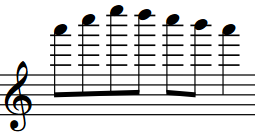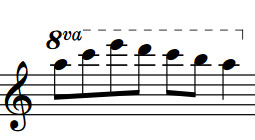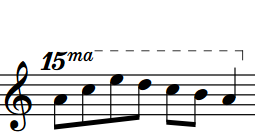Octave lines
Octave lines indicate where notes are played higher/lower than they appear in the score or part. They are dashed or dotted horizontal lines with an italic numeral at the start. The numeral indicates the number of pitches by which the phrase is changed, such as 8 for one octave and 15 for two octaves.
Octave lines that indicate notes are played higher than notated are placed above the staff, while octave lines that indicate notes are played lower than notated are placed below the staff.

|

|

|

|

|

|
In Dorico Pro, pitches are adjusted automatically when an octave line is present. You do not have to change the register of the notes within octave lines.
Octave lines should be horizontal, meaning they can take up significant vertical space, as octave lines are usually placed outside all other notations. However, they can be placed within slurs and tuplet brackets if the slur or tuplet bracket is longer than the octave line. You can also change the angles of octave lines, for example, to fit around angular phrases better.
Octave lines can continue across system and page breaks. It is customary to show the numeral again at the start of each system as a reminder. Cautionary octave line numerals are usually parenthesized and the suffix is optional.